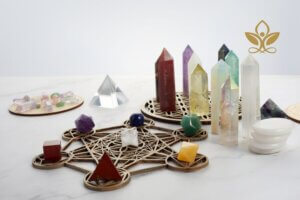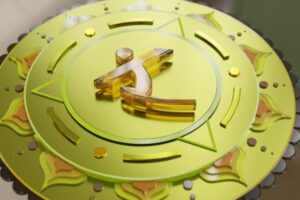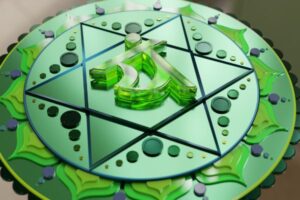Han Purple is a synthetic pigment that was first created by the Chinese over 2800 years ago. Albeit man-made, this pigment has been shrouded in mysteries ever since. The mystery is in the extremely technical preparation process, and then for its surprising magnetic effects.
And, although the journey of this technological marvel is rather dramatic, with lots of sudden disappearances and reappearances throughout the course of time, its properties never cease to amaze.
If you want to know more about this beautiful and interesting color, continue reading! Here are the history and the current facts about Han Purple.
Han Purple: a journey through time.
Han Purple was first produced around 800 BCE but didn’t get much attention in the world of arts until the rise of the Qin & Han Dynasty that lasted for more than four centuries from 200 BCE to 220 CE. Hence the name, Han Purple!
By the end of the Han Dynasty, the artificial pigment vanished from this planet as if it never existed, only to re-emerge in 1992 when modern scientists were finally able to figure out its chemical composition.
Han Purple: The genius design!
#5218fa – Hex Code for Han Purple
Making Han Purple or Chinese Purple required extreme precision. From grinding raw materials in precise proportions to heating the mixture at extreme temperatures. Everything had to be perfect. Not too hot, not too cold, i.e., the perfect Goldilocks conditions. Quite a sophisticated technology!
Han purple and Han blue (also called Chinese purple and Chinese blue) are synthetic barium copper silicate pigments developed in China and used in ancient and imperial China from the Western Zhou period (1045–771 BC) until the end of the Han dynasty (circa 220 AD).
Chinese were also the first to experiment with the chemical composition of other man-made purple pigments of that time: the Egyptian Blue and the Maya Blue. Egyptian Blue being the oldest with its first production dating back to as early as 3600 BCE. Maya Blue on the other hand was first synthesized around 800 BCE, same as our mysterious Han Purple.
The Egyptian Blue was a mixture of silica, copper, and calcium whereas the Chinese made their purple pigment by mixing, grinding, and heating silica, copper, and barium, and that’s where the whole mystery lies!
Some believe that the Chinese stole or borrowed the Roman formula of Egyptian Blue and replaced the calcium with barium, and some say that they were trying to make glass and the pigment was just an unexpected by-product. Despite various debates in the scientific community, the reason behind the idea of synthesizing Han Purple remains unclear. But that’s not the only thing that has baffled scientists for so long.
Several studies have been carried out to understand its magical properties since 1992, and as I said, it never ceases to amaze.
Han Purple: The magic pigment.
Magic is a contrary term for some scientists but I believe that magic is only that for which there is not yet a scientific explanation. But, the fact remains that Han Purple baffles even quantum physicists. To begin with, Han Purple emits powerful light in the near-infrared region which evidently shows one of its many potential fluorescent properties. It can also give extraordinary clarity under the right light conditions which the normal human eye fails to see.
In RGB color space, hex #5218fa (also known as Han purple) is composed of 32.2% red, 9.4% green, and 98% blue. Whereas in a CMYK color space, it is composed of 67.2% cyan, 90.4% magenta, 0% yellow, and 2% black. It has a hue angle of 255.4 degrees, a saturation of 95.8%, and a lightness of 53.7%. #5218fa color hex could be obtained by blending #a430ff with #0000f5. Closest websafe color is: #6600ff.
⎆ The magnetic field under low temperatures.
Then there’s its inherent superpower to manipulate the magnetic field under low temperatures. For instance, losing one of its dimensions to become a 2-dimensional structure from an original 3-dimensional when put under Goldilocks conditions. In this case, the magnetic field above 800,000 times the Earth’s and temperature below 1˚Kelvin).
⎆ The layered structure of the barium copper silicate components.
Scientists firmly believe that it has something to do with the layered structure of the barium copper silicate components. They believe these confuse the magnetic wave in some way and force the pigment to lose its vertical dimension.
In any case, properties such as these make this ancient marvel a promising superconductor for our future quantum computers. Additionally, it is a legit reason for our quantum physicists trying to understand the pigment: Han Purple!
Continue Learning About How Color Affects Lives
It’s no small wonder that colors have a huge impact on human existence. Of course, that’s why the topic of how color affects lives so fascinating. Moreover, because color affects our intimate environment in some very intrinsic ways, it is important that we continue to learn about color and how it affects us as human beings.
Below is a great little book about color that I just downloaded on my Kindle reader so, I’m sharing it with you!

Conclusion
It is our wish that you find this post enlightening and helpful. If you have any questions or suggestions, we love to hear from you in the comments below. Also, kindly accept our invitation to join our group on Facebook to surround yourself with kindred spirits and post your encouraging messages.









































